Small Mercies by Dennis Lehane
There’s a refrain that spans time and distance. When circumstances are what they are, someone will shrug and say, “It is what it is.” In Dennis Lehane’s gritty new novel, Small Mercies, the residents of 1970s South Boston say this, along with such things as “Whatta ya gonna do.” It’s not a question, of course, because it’s a given that, with some things, there’s nothing you can do. The Irish American inhabitants of South Boston embrace both pride and defeat. They proudly call their neighborhood Southie, yet they know that no matter how hard they work, being poor is a lifelong reality. It is what it is.
Mary Pat Fennessy’s first husband died and her second husband walked out on her. After her son returned from the Vietnam War, he became hooked on heroin and overdosed. So that leaves just her and her teenage daughter, Julia (or Jules), sharing an apartment in Southie’s Commonwealth housing project.
Mary Pat “looks like she came off a conveyor belt for tough Irish broads.” She’s small, but—as with so many other Southie kids who grew up in “Rock ‘Em Sock ‘Em Robots” households—she’s ready to fight. Her mother once told her, “You’re either a fighter or a runner. And runners always run out of road.” Not that Mary Pat needed to be told that, really. It’s not as though there was anywhere to run within the cramped household.
Jules is different. There’s a softness to her that Mary Pat has never known but nevertheless tries to foster. Once, when walking with Mary Pat, Jules explodes into tears on a Southie sidewalk, prompting stares from others. Mary Pat, in turn, holds her daughter, proud “of this weak child she’s borne.”
Still, it’s Southie after all, where “most kids come out of the womb clutching a Schlitz and a pack of Luckies.” Here, Jules is no different, which Mary Pat accepts. And if Jules can stay away from some harsher influences (such as the heroin that killed her brother), she might be okay, Mary Pat thinks.
There’s something else raising May Pat’s ire. It’s 1974 and a court-ordered mandate to desegregate public schools is galvanizing Southie. Some white students from South Boston High School are to be bused to Roxbury High School, a predominately African American school. Jules is going into her senior year assigned to Roxbury. Mary Pat is having none of this. Nor are Southie residents accepting that some Roxbury students will attend South Boston High.
It’s in this charged environment that a young black man is found murdered in Southie. On the same night, Jules goes missing. A homicide detective, Bobby Coyne, investigates the murder as Mary Pat desperately tries to find her daughter. Are the murder and disappearance related? Bobby knows that he has a tall order in trying to solve a murder in Southie, its residents an “unknowable tribe.” Mary Pat, part of that tribe, must cross boundaries within her own neighborhood, which takes her into the world of Marty Butler, a neighborhood mobster who’s clearly a stand-in for real-life mobster Whitey Bulger.
Lehane not only keeps the plot rolling, his characters have depth. And throughout, there are nuances that place you right in the scene. When Mary Pat’s niece, for example, is described as “a girl who’s always managed to be twitchy and listless at the same time,” we see her, know her a little already. And, trust, Mary Pat certainly doesn’t stand apart from her neighbors when it comes to prejudices.
The Southie in this novel is not unlike other enclave neighborhoods. It possesses both benevolence and hate. It has a mobster who claims to protect his neighborhood, his people. But in reality, it’s “his people” he hurts the most. It, like neighboring Roxbury, has parents willing to do anything to protect their children from harm. But they know that, in the end, they can’t.
“It is what it is” may seem like a throwaway line. Frequently it is, to be sure. But it also embodies the heartbreaking reality that we, at times, live in an unjust world that metes out punishment for the simple audacity of being alive. The poet Charles Bukowski said there’s often “pain without reason.” Sure, you can unpack the events. But as Bobby says to Mary Pat: “This life. You know? Try and make sense of it.” Well, she does see how it is. And she’s done with anything resembling “Whatta ya gonna do.” She’s rendering judgments. And those on the receiving end had better watch out.
Reviewed by Jason Sullivan











